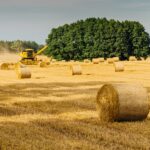* This interview was conducted ahead of the Cultivate Conference which took place on July 15, 2021.
Rebekah Carlson will be speaking at the Cultivate conference on the company she works for, Nori, a carbon removal marketplace. In the marketplace, Nori credits with Nori Removal Tonnes (NRTs) and make them available for purchase by companies and individuals. One NRT represents one metric ton (tonne) of carbon removed from the atmosphere and retained in a reservoir. While Nori is carbon removal agnostic, their first methodology is focused on storing carbon in agricultural soils. Nori issues NRTs to producers in the US who have adopted regenerative practices since 2010 that result in incremental carbon storage in the soil.
To estimate the amount of carbon removed and retained in the soil, Nori collects agronomic data from growers to run through Soil Metrics, their carbon quantification tool, which combines these data with soil and weather patterns to estimate increases in soil organic carbon (SOC) as a result of the regenerative practice.
Once the data is in and Soil Metrics has run its models, Nori estimates how many NRTs a producer is issued based on their new practices. The project then goes through verification, a third-party audit ensuring the agronomic practices used to run the models did, in fact, take place. Additionally, if the grower is not the landowner, they will need to demonstrate to the verifier that they have authority from the landowner to participate in our marketplace.
After verification passes, the producer signs an NRT agreement, which commits a producer to maintaining the carbon in the soil for 10 years, updating project data for 10 years, verifying the project at least every three years, and choosing their own price for their NRTs.
The NRTs are then listed on our marketplace in a First in First out (FiFo) queue, to be purchased by individuals and companies offsetting their emissions.
How can farmers partner with Nori?
Farmers can partner with us by going to our website, clicking on the “enrollment button” and filling out a form. This form helps us understand their qualifications for the Nori Pilot. We will then personally connect the farmer with our Nori Data Managers, a trusted group of partners who have been trained in the Nori enrollment process to onboard growers into the Nori Marketplace.
Why is carbon removal important?
Carbon removal is important both on a global and on a local scale, particularly for farmers. I’ll start with globally. We currently have too much carbon in the wrong place: the atmosphere. There are a slew of consequences from having the carbon here and we need a strategy to not only emit less CO2, but remove the excess CO2 to maintain healthy ecosystems across the globe, including the Midwest. Carbon removal plays a role in this by taking additional carbon out of the atmosphere and putting it in a place that is helpful, ecologically speaking, and not harmful.
From a local scale, farmers are removing carbon everyday through the crops they plant. By quantifying this carbon and creating an asset out of it, carbon removal provides an additional source of income to the farming community, which is plagued by volatile weather and many tight margins. By adopting practices that put carbon back in the land, this removal provides resilience to both the pocketbooks and the soil of a grower.
What does carbon removal look like with Nori?
Our first and current methodology of carbon removal at Nori is through the incremental drawdown of carbon stored in US croplands’ soils based on recently adopted regenerative agricultural practices. We have assurance through our NRT agreement that this carbon removal will remain in the soil for a minimum of 10 years.
Is the process of Carbon capture disruptive in any way to a farmer’s day-to-day processes?
Yes. Adding in any new change or way of thought to a fairly engineered agricultural process is going to be a bit disruptive. As we pioneer our way through introducing carbon removals as a valuable commodity to growers, we kind of want to rock the boat a bit. But the extent of the disruption depends on the producer. For producers who have recently adopted regenerative practices, the disruption is small. They continue stewarding the land well and the disruption comes in the form of data management and data entry into our carbon quantification tool. Yet for producers who are going to adopt regenerative practices, carbon removal is quite disruptive. Changing practices takes gumption and is very farm dependent. The process of determining what to plant, when to plant, how to account for weather, machines breaking down, using new equipment, among many other decisions is very specific to any given field. While these changes take time, mistakes, and capital, Nori wants each producer to make the best decisions for what makes sense for their land when switching over to regenerative practices. We know it is a risk, but we hope that carbon markets provide an economic incentive to help ease the transition through
these changes.
How does Nori utilize the blockchain?
Nori utilizes the blockchain in a couple different ways. For one, all of the NRTs that we issue are listed on the blockchain, meaning they are a traceable asset with full transparency behind to whom the NRTs are issued and who is buying them. This accountability provides assurance that NRTs listed in the Nori Marketplace can never be double counted. The second manner in which Nori uses the blockchain is through the soon-to-be-minted NORI, a digital token representing one NRT. After we are through the pilot phase of the Nori Croplands Methodology, NRTs will be traded through NORI. By doing this, we are assuring true price discovery of the NRT, giving producers the ability to play the market a bit by holding on to their digital commodity (NORI) to sell their NRTs if they think the price will jump, and it also allows Nori to create a carbon market that scales.
Also, we understand that cryptocurrency may be a bit too techie for some in already new territory, and we are investigating the option for growers to be paid directly in cash, and bypass the token aspect entirely.
What are some challenges that Nori faces?
Oh, there are plenty. Striking the balance between a young field of science of carbon storage in soil, meeting buyers’ requests, and building a product suitable for our producers comes with a whole host of… challenges. Opportunities, one may say. A major challenge we encounter almost every day is dealing with unrealistic expectations. With a lot of hype around carbon right now, it is a bit of the wild west when it comes to how much carbon soil can store, what are appropriate tools for measuring carbon, how long the process should take, what the price should be, and the list goes on and on. At Nori, we want to work conservatively and accurately with the tools we have, which are calibrated and validated by the soil sampling in the scientific community to build a marketplace fueled by science and serving our customers (both suppliers and buyers) well. So when the hype settles down, we can still move forward.
What would you tell a grower that might be skeptical of working with Nori?
Nori is a marketplace designed in a farmer-facing manner— we do not mandate practices, do not place covenants on the property— we issue NRTs based on the carbon sequestered due to a new practice a grower chooses to adopt. But, as this is a new phase of agriculture, there should be skepticism. If you are skeptical, my best advice is just to wait and see. Poke around at the different options, keep an eye on what is working, what isn’t, and just keep managing your farm well. I believe that carbon markets are not just a cool new trend, but are here to stay, so if the market suits you better after it is more established, that may be the best decision for your operation. We’re not here to pressure. But, for those who want to jump on board, now is the time. It is new and exciting and, in these early stages, there are many opportunities and benefits in place that will not be there in an established market.
What are you hoping to highlight during your participation in the panel?
I hope to paint a realistic picture of where Nori, and carbon markets, stand. Many folks are looking for a perfect silver bullet, and tools that match the wonderfully innovative practices that many farmers have implemented. But our tools are simple compared to agronomic norms and the markets are young. While we are starting somewhere, though simple, there is plenty of exciting room to define and create the processes we need to scale carbon markets to suit all farmers.
Is there anything else you want to say to growers?
There are many options for carbon markets right now. Look into the data requirements, contracts, data ownership, lift of entry and see what works best for your operation. If all carbon opportunities scale, I believe we all win. The main goal is about changing the landscape of agriculture in a way that stewards the environment, the longevity of the land and the financial well being of a farmer. So if we have many approaches to making that happen… rock on.




